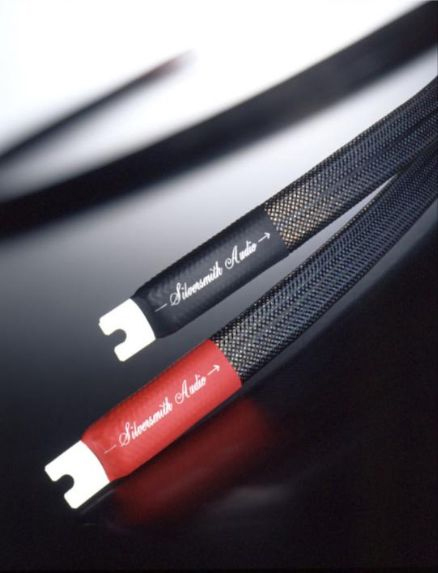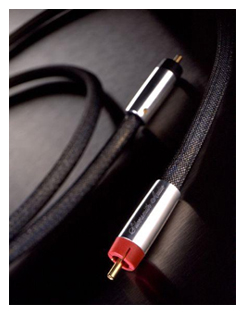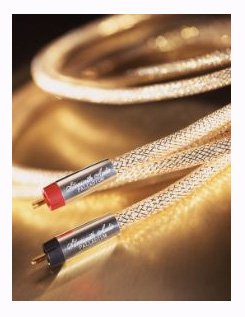You are reading the older HTML site
Positive Feedback
ISSUE
21
silversmith
Silver and Palladium cables
as reviewed by Fown-Ming Tien

|
FOWN-MING TIEN'S SYSTEM:
LOUDSPEAKERS
ELECTRONICS
SOURCES
CABLES
ACCESSORIES |
I have long considered cables to be relatively insignificant items in an audio system. Sure, they could make a difference, but never as large a difference as a component upgrade. After spending countless hours swapping interconnects behind my audio rack, I came to view cables as fine-tuning devices. Cable A compared to Cable B offered a bit more in this area than another, while cable D offered less of this and more of that compared to cable A, B, and F, but cable G did certain things better than all of the above in nearly all areas. You get the picture. I came to feel that if you chose well designed interconnects, the differences weren't all that large, especially considering the differences in price. I finally realized that my Aragon Palladium monoblocks would never sound like a Levinson, Rowland, Pass, or Audio Research tube amp regardless of which interconnects I tried, so I decided to be content with the CryoTweaks Silver Reference MkIIs. I felt that they offered performance and value while saving money for upgrades to system components.
It is therefore only by serendipity that I am writing this review. I was in the process of reviewing the excellent Dodson DAC-263, and was happily enjoying my system until Ralph Dodson, president of Dodson Audio, insisted that I experiment with a digital cable he had had a hand in designing. When I hooked up the cable, I was not expecting much of a difference, but was absolutely astonished at what I heard. Focus was tighter and more controlled across the board, but more importantly, I heard a much more truthful presentation of the source material. This was the first time that a cable made almost as much of a difference as a component upgrade, so when I visited Ralph to return the cable, I asked for his recommendations on speaker cables and interconnects. Ralph has forgotten more about great-sounding audio than I will ever know, so when he talks, I listen. He recommended the Silversmith Audio ribbon cables, but despite the source of the suggestion, I was surprised to hear the word "ribbon" since my experiences with the Ridge Street Audio Midnight Silver Generation II interconnects and speaker cables, the Luminous Audio Synchestra Reference interconnects, as well as some Audio Magic ribbon cable offerings, had been less than satisfactory. I mentioned this to Ralph, but he insisted that the Silversmith products were different and that I should give them a listen.
Hearing new products is always interesting, so I contacted Jeff Smith of Silversmith. After equipping my entire system with his cables, I discovered that they were very special. In fact, I consider them downright revolutionary. Before I go on, let me offer a word or two of advice. If you cannot afford to purchase Silversmith cables, do not—I repeat, DO NOT—audition them, and stop reading this review now. The Silver interconnects are $1400 for a three-foot pair, and the Palladium interconnects are $4000 for the same length. If you ignore this warning, you are asking for trouble.
Jeff sent three pairs of his Silver interconnects, two pairs of his Palladium interconnects, and two pairs of the Silver speaker cables (for bi-wiring). Each set of Silversmith cables comes in its own beautiful, brushed aluminum jewelry case. All use extremely thin, flat ribbon conductors designed to minimize skin effect, eddy current phenomena, and the associated phase shifts. The foil-like conductors are suspended in thin Teflon tubes to maximize the air dielectric and therefore minimize the colorations of solid dielectrics, which store and release more electromagnetic energy and at different rates. All Silversmith cables use exactly the same geometry, and are designed with the goal of minimizing or eliminating these deleterious effects. The only difference between the Silver and the Palladium cables is the conductor material. As the name suggests, the Silver cables use pure silver conductors, of a temper specifically chosen to reduce the number of grains. Terminations for the interconnects are either Neutrik (for XLR applications) or copper Eichmann Bullet Plugs (for single-ended applications). All are outfitted with custom silver-plated barrels engraved with the Silversmith name and arrows for directionality. Lastly, the interconnects utilize a silver-plated copper RF/EMI shield and are wrapped in black techflex mesh.
Because the Silversmith cables use air as their primary dielectric, minimal break-in time is required, so you won't need a cable cooker or months and months of playing time to hear them at their best. Before hearing the Silversmith interconnects, the most impressive interconnects I had heard in my system were the AudioQuest Sky and the Harmonic Technologies Cyberlights. I started by replacing the Sky interconnects between the McCormack UDP-1 and the Aesthetix Callisto. Although I have had experience with a wide variety of cables, nothing could have prepared me for the dramatic differences I heard. The Silversmith Audio Silver interconnects brought new levels of clarity, dynamics, neutrality, and balance. They lacked all of the colorations I had heard in other cables.
 The
first thing I noticed was the huge improvement in clarity and control on
percussion instruments. While I had heard this effect with other cables,
this was the first time that the difference was so dramatic. Many
manufacturers claim that their interconnects minimize phase shift, but the
Silversmith Silver interconnects were the first to truly illuminate this
deleterious effect. Cymbal strikes and snare drum thwacks had cleaner and
tighter attack, and the smoothest sustain and decay I had ever heard. There
was none of the splashiness or dullness of timbre that I have heard with
other cables. Phase shift causes smearing in the time domain, which softens
dynamics, blurs nuances, subdues texture, and minimizes depth. It also
causes dynamic transients to sound slow, greatly detracting from the
system's ability to reproduce music realistically. I threw in Sunshower,
Blueport's DVD-A recording of the John Hicks Trio, and could hear the brush
being applied to the cymbal with varying degrees of pressure. I had never
been able to hear this in the past.
The
first thing I noticed was the huge improvement in clarity and control on
percussion instruments. While I had heard this effect with other cables,
this was the first time that the difference was so dramatic. Many
manufacturers claim that their interconnects minimize phase shift, but the
Silversmith Silver interconnects were the first to truly illuminate this
deleterious effect. Cymbal strikes and snare drum thwacks had cleaner and
tighter attack, and the smoothest sustain and decay I had ever heard. There
was none of the splashiness or dullness of timbre that I have heard with
other cables. Phase shift causes smearing in the time domain, which softens
dynamics, blurs nuances, subdues texture, and minimizes depth. It also
causes dynamic transients to sound slow, greatly detracting from the
system's ability to reproduce music realistically. I threw in Sunshower,
Blueport's DVD-A recording of the John Hicks Trio, and could hear the brush
being applied to the cymbal with varying degrees of pressure. I had never
been able to hear this in the past.
Eva Cassidy's voice on her CD Songbird had emotion it had never had before, and the dynamic range of the recording was simply incredible. Every track on the album brought goosebumps. Every breath she drew, every quiver in her voice, was transmitted with more passion that I had ever heard. With less phase shift, backgrounds sounded blacker. Dynamic shifts were lightning fast, with much more explosiveness. The speed and precision did not come at the expense of naturalness, as there was no etch or harshness. Unlike other silver cables, voices did not sound recessed. There were no dips in the upper bass or lower midrange regions, nor were they pronounced, as they can be with copper cables. The bass on Mobile Fidelity's SACD of Patricia Barber's Modern Cool was tight and clean, with no overhang, nor was it artificially lean. I would never have guessed that I was listening to silver interconnects. In fact, the Silversmith Silvers did not sound like any interconnects I had heard. They were the purest, and most realistic sounding. If you are looking for musical truth, they are the best in the under-$2500 category. I must admit that, other than the Silversmith Palladium cables, I have not heard many interconnects in the over-$2500 price range in my system, so the Silvers might even compete with cables costing far more than $2500. While they are not inexpensive, considering the tremendous benefits they brought to my system, I'd say they are the biggest bargains in high-end cable.
Had my experience with Silversmith cables stopped there, I would have been convinced that the Silvers were the most truthful interconnects available, but then I spent a few brief weeks the Palladiums. The only external difference between the Silvers and Palladiums is the gold mylar mesh that covers the Palladiums. Internally, they use the same thin Teflon tubes to house the ribbons. Since the conductivity of pure palladium is inferior to that of silver, I asked Jeff Smith why he used this material? He explained that he uses a palladium alloy rather than pure palladium, and that the alloy has energy storage characteristics that are up to 25 times better than those of pure silver, copper, aluminum, gold, or pure palladium.
While the Silvers are the best interconnects I have heard in the $2500-and-under category, the Palladiums are the best I have heard, period. They sound extremely similar to the Silvers. Everything I said about the Silvers applies to the Palladiums, but to a greater extent. The highs are even more glorious. The bass is cleaner and tighter, and has far more texture. With the Von Schweikert VR-4 Jrs not loaded (as they can be) with lead shot, the bass was overpowering, possibly because of the lack of mass loading. Focus was even more precise and controlled, with no compromise in musicality. Sarah McLachlan's voice and Stan Getz' saxophone had unparalleled texture, allowing more emotion to come forth. Highs were clean, extended, and smooth. Dynamics were simply slamming. Imaging was tight and precise, and the soundstage was impeccable. If you are seeking absolute sonic truth, these are the best interconnects you can buy. They will not warm up a lean-sounding system, nor will they tone down a bright one, but they will allow every bit of detail in the source material to emerge completely unimpeded. I played the John Hicks Trio's Sunshower again, listening intently for the brushwork. Clarity, nuance, and definition were even better than before. I could practically see and feel the brush moving around the cymbal. The soundstage in large orchestral pieces was the most precise I had ever heard. I could pinpoint the position of a trumpet call in Dvorak's New World Symphony. In the past, it had simply come from the same general vicinity as the wind section.
I was so amazed by and enamored with the Palladiums that I called one of my audio buddies and told him to hurry over to hear them. After hearing the Palladiums, he immediately outfitted his system with them! I also brought the Palladiums to the home of fellow PFO reviewer Robert Levi, where we experimented with them in both his primary and secondary systems. Although I was only able to hear them there briefly, I felt that they made as dramatic an impact as they had made in my system.
 Hearing
the Palladium interconnects in yet another system served to solidify my
opinion of them. Mike Garner of Tweekgeek.com hosted a listening session at
his home and invited a number of local audio enthusiasts. My friend who had
purchased the Palladiums brought them to this session, along with his EMM
Labs DCC2 DAC/preamplifier. The system we heard that day also contained a
pair of NuForce Ref 8 monoblocks, my McCormack UDP-1 universal disc player
(used as a transport), and a pair of SP Tech 2.1 speakers. The system
sounded fantastic, but when the Palladiums went in, it suddenly reached a
new level. It was more open, airy, and balanced than before. As with the
other systems in which I had tried the Palladiums, images were precisely
anchored and sharply focused. Bass had improved weight and definition. The
midrange and highs were faster and cleaner, with excellent transparency.
While the EMM Labs gear was in no small part responsible for the world-class
sound, the system was dramatically inferior when the Palladium cables were
removed.
Hearing
the Palladium interconnects in yet another system served to solidify my
opinion of them. Mike Garner of Tweekgeek.com hosted a listening session at
his home and invited a number of local audio enthusiasts. My friend who had
purchased the Palladiums brought them to this session, along with his EMM
Labs DCC2 DAC/preamplifier. The system we heard that day also contained a
pair of NuForce Ref 8 monoblocks, my McCormack UDP-1 universal disc player
(used as a transport), and a pair of SP Tech 2.1 speakers. The system
sounded fantastic, but when the Palladiums went in, it suddenly reached a
new level. It was more open, airy, and balanced than before. As with the
other systems in which I had tried the Palladiums, images were precisely
anchored and sharply focused. Bass had improved weight and definition. The
midrange and highs were faster and cleaner, with excellent transparency.
While the EMM Labs gear was in no small part responsible for the world-class
sound, the system was dramatically inferior when the Palladium cables were
removed.
Jeff had told me that his interconnects could be used as digital cables, so I decided to try them between my McCormack UDP-1 and the Dodson DA-218 DAC, on a day when I was hosting a listening session at my home. The results were stunning. Both the Silver and the Palladium interconnects blew away every digital cable we tried, including the one that came from Ralph Dodson, which had already outperformed all others, regardless of price. Once again, the benefits were startling clarity and focus, and the Palladiums sounded just like the Silvers, only better.
The final Silversmith cables I tried were the Silver ribbon speaker cables. Like the interconnects, the speaker cables are suspended in Teflon tubes to minimize physical contact with the ribbon conductor while maximizing the air dielectric. The spade lug terminations are notches in the ribbons, which in theory is the best possible termination since it eliminates the sonic degradation introduced by the use of a soldered or crimped connector. While the Silversmith interconnects had been easy to use, installing the four separate runs of wide silver ribbon on my Rowland amp was an exercise in frustration. The amp has Cardas binding posts that crimp both the positive and negative speaker wires simultaneously, and it was impossible to hold four runs of speaker cable in place with one hand while tightening the binding post with the other. Fortunately, my amp is on an exposed amp stand, so Jeff was able to offer a helping hand. If you are not running bi- or tri-wire speaker cable configurations, and not using Cardas connectors, installation should be straightforward, although since the ribbons are fairly wide, they also will not work with the plastic-encased WBT binding posts.
Not surprisingly, the speaker cables offered improvements identical to those of the Silver interconnects. Try as I might, I was unable to find any flaws, weaknesses, or compromises in my system with the Silversmith cables in place. Because they get timing and focus right, I have come to realize that phase issues cause many of the sonic gremlins in our systems. The Silversmith cables address time and phase problems like no others. They deliver the truth and nothing but the truth, and do so more correctly than any other cables I have experienced. As a result, they have become my new cable references. If I had four thumbs, they would be the first to receive a four-thumbs-up rating! Since I don't, I can only rate the Silversmith cables with an unprecedented ten fingers and ten toes. Fown Ming-Tien
Silver speaker cables (6' pair) and Silver
interconnects (3' pair)
Retail: $2500 and $1400, respectively.
Palladium speaker cables (6' pair) and Palladium
interconnects (3' pair)
Retail: $9800 and $4000, respectively.
Silversmith
web address:
www.silversmithaudio.com
